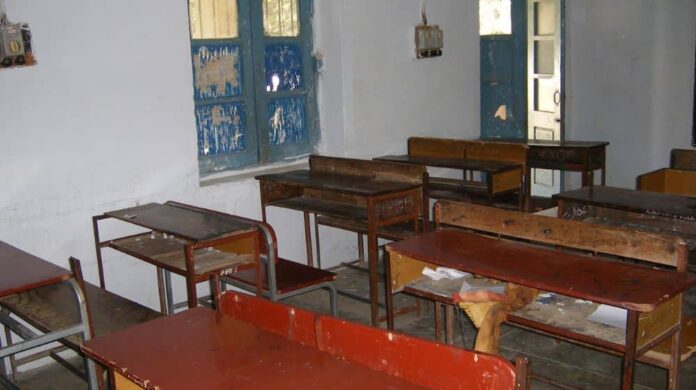In a small village in the heart of Sindh, young kids eagerly put on their school bag every morning, full of hope and big dreams in their eyes. But each day, when they walk into the old school building, they only find silence and an untouched blackboard. There wasn’t a teacher there to help, or someone to make them love learning.
However, just a short distance away in the town center, a man got paid every month for ‘teaching’ at this school. Some people quietly called him a ‘ghost teacher’ because, even though his name was on the list, he never showed up to teach. This isn’t just one kid’s story; it’s sadly the same for many children in Pakistan, waiting for a teacher who might never come.
In Pakistan’s education system, there are parts that, when looked closely at, show some big problems. The idea of ‘ghost teachers’ is one of them. All over Pakistan, from big cities to far-off places, there are teachers who are listed and get paid, but no one ever sees them teaching. This isn’t just a small mistake; it’s a big issue that could stop Pakistan from reaching its education goals.
While the problem of ghost teachers in Pakistan is deeply rooted, solutions exist. By taking cues from international successes and aligning with global commitments, Pakistan can chart a way forward, ensuring every child has access to dedicated and genuine educators. The journey ahead demands collective will, resilience, and unwavering dedication to the nation’s future. After all, an educated populace isn’t just a marker of progress; it’s the backbone of a nation’s aspirations, dreams, and its place in the global tapestry
Pakistan’s education system, riddled with the anomaly of ‘ghost teachers’, bears testament to a larger issue of systemic mismanagement and corruption. To fully understand the reasons behind this phenomenon, it is essential to delve into its historical and sociopolitical dimensions.
After independence in 1947, Pakistan was tasked with the mammoth job of developing an education system from the ground up. The massive nationalization drive during the Bhutto era in the 1970s, which saw the state taking over numerous private educational institutions, exacerbated the situation. This initiative, though well-intended to democratize education, swelled the public education sector without the requisite administrative overhaul. As a consequence, the system became susceptible to manipulation and inefficiency. The state, caught in the labyrinth of managing countless schools, often overlooked teacher attendance and performance.
By the 1980s, evidence was mounting of an escalating issue. Positions within the educational sector, particularly in rural regions, became instruments of political patronage. In many instances, these were rewards for political loyalty rather than merit-based appointments. Favouritism and political involvement in the education system along with bureaucratic failures of oversight made the issue worse.
Fast forward to recent times, the National Education Policy of 2009 noted the grim reality of teacher absenteeism across the country. However, despite acknowledging the issue, the mechanisms to combat it remained frail. Remote areas, with minimal infrastructure and oversight, became hotbeds for ghost teachers.
The most direct consequence of ghost teachers is the grave educational void they leave behind. As these teachers fail to show up, students, especially in remote areas, remain deprived of their basic right to education. This neglect leads to alarming rates of illiteracy. According to a UNICEF article, Pakistan has the second-highest number of out-of-school children globally, with the ghost teacher phenomenon significantly contributing to this statistic. The ripple effect of this is the widening educational disparity, where urban areas with better oversight progress, while rural regions, affected more by the phenomenon, fALL even further behind.
Ghost teachers, while absent from classrooms, continue to draw salaries from the public coffers. This misuse of taxpayer money leads to millions, if not billions, being wasted every year. Instead of these funds being channeled into improving school infrastructure or investing in educational technology, they are siphoned off unproductively. In a country like Pakistan, with constrained resources, such wastage exerts additional pressure on an already strained economy.
The long-term societal impact of the ghost teacher predicament is profound. A generation of students not receiving adequate education means a workforce ill-prepared for the challenges of the modern world. This has a cascading effect on the nation’s potential for innovation, technological advancement, and competitiveness in the global arena.
Pakistan’s commitment to various international conventions, such as the Sustainable Development Goals, particularly SDG 4 which aims for inclusive and equitable quality education, is undermined by the ghost teacher issue. The persistent problem not only dents its international image but can also affect potential educational grants, partnerships, and collaborations from international bodies.
Across the globe, many countries have faced challenges similar to Pakistan’s ghost teacher conundrum. However, their methods of resolution can offer insight. In India, for instance, the introduction of biometric attendance systems in certain states has curtailed teacher absenteeism. Although there has been recent development in Pakistan, it also requires sheer vigilance and monitoring. In Nigeria, the Kaduna state implemented a competency test for teachers, which not only identified unqualified teachers but also ensured those employed were genuinely committed. These international examples underscore the need for both technological solutions and policy reforms to address the issue effectively.
Localized control and community involvement can be instrumental in combating ghost teachers. Communities that are directly involved in their schools are more likely to monitor and report absent teachers. The introduction of stringent oversight mechanisms, such as surprise inspections, digital attendance systems, and performance evaluations, can be instrumental. Robust legal frameworks that punish absenteeism and corruption can deter potential ghost teachers.
Engaging with international educational bodies can provide Pakistan with not only financial support but also valuable expertise. Such collaborations can lead to the development of solutions tailor-made for the country’s unique challenges.
While the problem of ghost teachers in Pakistan is deeply rooted, solutions exist. By taking cues from international successes and aligning with global commitments, Pakistan can chart a way forward, ensuring every child has access to dedicated and genuine educators. The journey ahead demands collective will, resilience, and unwavering dedication to the nation’s future. After all, an educated populace isn’t just a marker of progress; it’s the backbone of a nation’s aspirations, dreams, and its place in the global tapestry.























